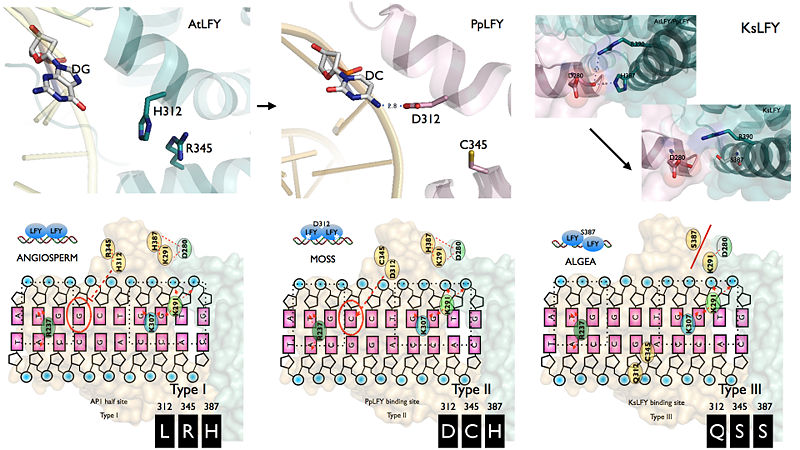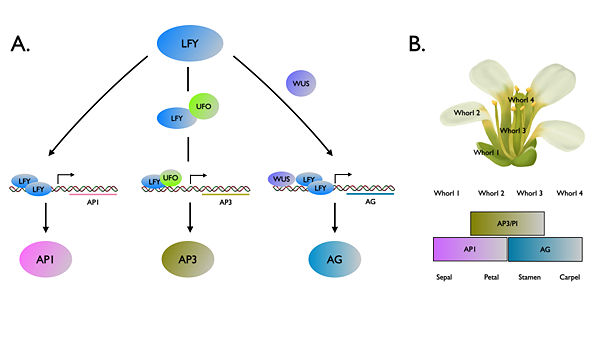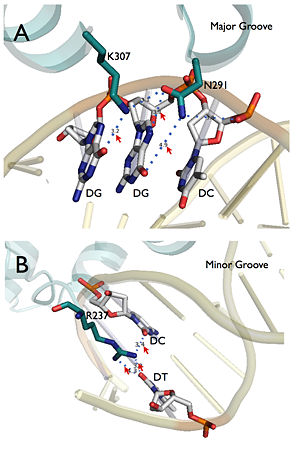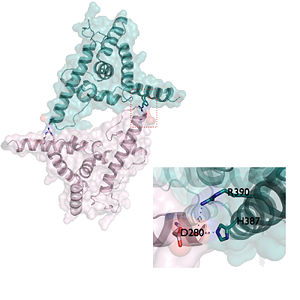Sandbox Reserved 933
From Proteopedia
| This Sandbox is Reserved from 01/04/2014, through 30/06/2014 for use in the course "510042. Protein structure, function and folding" taught by Prof Adrian Goldman, Tommi Kajander, Taru Meri, Konstantin Kogan and Juho Kellosalo at the University of Helsinki. This reservation includes Sandbox Reserved 923 through Sandbox Reserved 947. |
To get started:
More help: Help:Editing |
Contents |
Evolution of DNA binding domain of LEAFY
Introduction
FLORICAULA/LEAFY (FLO/LFY) genes encode a plant specific transcription factor family that controlling floral fate of reproductive phase. [1][2]. In the plant model system Arabidopsis thaliana , ‘’LFY’’ also acts upstream of floral homeotic genes to modulate floral organ identity. [3] LFY activates the downstream genes by binding to promoter regions. LFY can directly bind to the promoter to APELATA1 (AP1), while co-regulators UNUSUAL FLORAL ORGANS (UFO) [4] and WUSCHEL (WUS)[5] are required for increment of binding affinity to promoter regions of APELATA3 (AP3) and AGAMOUS (AG), respectively (Figure 1). The exact mechanism how LFY recognizing and binding to these promoters has yet to be elucidated until the first structure report about two DNA-protein complex: and [6] . Among land plants, FLO/LFY homologs share a highly conserved DNA binding region that a hypothesis claimed substitution in this domain might result in the functional divergence[7] . Recently, a new structure about LFY homolog in mosses provided new insights of structural basis of how LEAFY evolved by changing DNA binding activity[8]. In this page, we will focus on the structural basis about LEAFY evolution by DNA binding.
| |||||||||||
LEAFY Evolution

Different from other transcription factor families, LFY and its homologs retains as a single copy gene in almost all land plants. This brought a new entry point that how LFY evolved to control different developmental processes in other plant lineages. LFY homologs in mosses have been reported controlling cell division, through binding to a different motif rather than the one that was found in Arabidopsis. Multiple alignment and a new method by systematic evolution of ligands by exponential enrichment (SELEX) of LFY and its homologs revealed that at specific position, few amino acids were substituted from angiosperms to algae to bind to specific motifs. Such motifs can be further categorized into three subgroups: Type I (angiosperm), type II (mosses) and type III (algae), which probably result in a diverged functionality. Crystal structure of DNA-protein complex composed of a moss LFY homolog from Physicomitrella patens and its binding sites further validated this hypothesis. In Arabidopsis, site specific recognition of LFY is conducted by two residues located at a HTH motif. Interestingly, another residue 312D was found in the HTH motif mediating direct site specific recognition to a cytosine at the major groove.(figure 4, PpLFY) In contrast, 312 was occupied by a histidine and bond to a residue R345 from α7 in Arabidopsis, and the DNA binding motif at the position is a guanine instead of a cytosine (figure 4, AtLFY). This structural difference finally result in a difference between type I and type II binding motif. Additionally, there are no difference in dimerization in binding type I and II motif, because three important residues mediating cooperative binding are not changed. In different from type I & II binding, LFY homologs in algea bind to the type III binding motif by a unique structure. Switching of His 387 to a Ser in the three critical cooperative binding site dramatically change the dimerization surface (figure 4, KsLFY). Here is a movie that showing how the LFY evolved. Surprisingly, a LFY homolog in hornwort, shares a promiscuous binding habit, that it can bind all three types of binding motifs. This phenomenon can be explained at structural. At 312 position, LFY homolog in N. aenigmaticus harbors a glutamine, which is identical to type algae LFY. However, 345C and 387H indicate the similar binding properties with type I and II. This finding give new insights about a single copy gene evolution, through a promiscuous intermediate. An interesting movie showing this progress very well: https://www.youtube.com/watch?v=Yvk3ond-WHk.
Reference
- ↑ 1.0 1.1 1.2 Weigel, D., Alvarez, J., David R., Yanofsky, M.F. & Meyerowitz, E.M. 1992. LEAFY controls floral meristem identity in Arabidopsis. Cell 69 :843-859, http://dx.doi.org/10.1016/0092-8674(92)90295-N.
- ↑ 2.0 2.1 Coen, E.S., Romero, J.M., Doyle, S., Elliot, R., Murphy, G. & Carpenter, R. 1990. Floricaula: a homeotic gene required for flower development in Antirrhinum majus. Cell 63: 1311–1322 http://dx.doi.org/10.1016/0092-8674(90)90426-F
- ↑ Irish, V. F. 2010. The flowering of Arabidopsis flower development. The Plant Journal, 61: 1014–1028. http://dx.doi.org/10.1111/j.1365-313X.2009.04065.x
- ↑ Chae, E., Tan, Q.K., Hill, T.A. & Irish, V.F. 2008. An Arabidopsis F-box protein acts as a transcriptional co-factor to regulate floral development. Development 135:1235-45 http://dx.doi.org/10.1242/dev.015842
- ↑ HONG, R.L., HAMAGUCHI, L., BUSCH, M.A. and WEIGEL, D. 2003. Regulatory elements of the floral homeotic gene AGAMOUS identified by phylogenetic footprinting and shadowing. The Plant Cell 15: 1296-1309. http://dx.doi.org/10.1105/tpc.009548
- ↑ Hames, C., Ptchelkine, D., Grimm, C., Thevenon, E., Moyroud, E., Gérard, F. Martiel, J.L., Benlloch, R., Parcy, F. & Müller, C.W. 2008. Structural basis for LEAFY floral switch function and similarity with helix-turn-helix proteins. EMBO Journal 27:2628-2637. http://dx.doi.org/10.1038/emboj.2008.184
- ↑ MAIZEL, A., BUSCH, M.A., TANAHASHI, T., PERKOVIC, J., KATAO, M., HASEBE, M. and WEIGEL, D. (2005). The floral regulator LEAFY evolves by substitutions in the DNA binding domain. Science 308: 260-263. http://dx.doi.org/10.1126/science.1108229
- ↑ Sayou, C., Monniaux, M., Nanao, M.H., Moyroud, E., Brockington, S.F., Thévenon, E., Chahtane, H., Warthmann, N., Melkonian, M., Zhang, Y., Wong, G., Weigel, D., Parcy, F. and Dumas, R. 2014. A Promiscuous Intermediate Underlies the Evolution of LEAFY DNA Binding Specificity Science 343: 645-648 http://dx.doi.org/10.1126/science.1248229
- ↑ Siriwardana, N. S. & Lamb, R. S. 2012. A conserved domain in the N-terminus is important for LEAFY dimerization and function in Arabidopsis thaliana. The Plant Journal 71: 736–749. http://dx.doi.org/10.1111/j.1365-313X.2012.05026.x8



